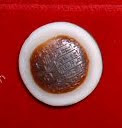It’s good to be back after a week’s vacation. Earlier this week I was giving a walk-through to some folks who were very interested in finding out about the oldest items in our collection. This is actually a question I’ve had several times, so for all of you who’ve wondered about this, here’s the answer.
Our oldest objects are the antiquities in our art collection, most of which do not have firm dates, however among the oldest objects are an Egyptian stele believed to date ca. 1800 B.C.E. and small sardonyx gem amulet with an inscription in the name of Nebuchadnezzar, King of Babylon from 606 to 561 B.C.E.
Our oldest printed book is a copy of the I Ching (Book of Changes), printed in China during the Sung Dynasty, about the tenth century. It is an example of a block book, in which each page is carved and printed from a separate wooden block. The Chinese were quite skilled at this printing method and in the sixteenth century Matteo Ricci noted that a Chinese carver could carve a page for a block book in about the same amount of time as a western typesetter could set a folio page. For more on this book, check out this old blog post from our former library assistant Greg Giuliano.

Our oldest example of Western printing is a single leaf from the Gutenberg Bible containing parts of Exodus, Chapters XVI-XVIII. If you’d like to see a complete Gutenberg bible, you can check out digital versions of the two copies at the British Library and the copy at State and University Library of Lower Saxony right from your desk, but to get you started, here’s our single leaf
Finally, I believe our oldest complete book printed with movable type is a copy of Cicero’s stoic treatise De Officii printed in Mainz in 1466.
I think that about covers it for the rundown of oldest items in our collection. Watch for future posts on things new, borrowed, and blue.




always good to reference a Jesuit